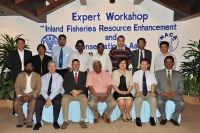Inland fishery resource enhancement and conservation in Thailand
7 February 2010 | Tuantong Jutagate and Achara Rattanachai | 3606 views | .mp3 | 6.73 MB | Genetics and Biodiversity, Stock enhancement, Thailand
The production from inland capture fisheries in Thailand is about 1 million tonnes per annum. To sustain this production, various types of resource enhancement and conservation practices have been implemented. Engineering the environment and fish stocking are the two major practices adopted, and closed-season fishing as well as control of fishing gears are used for conservation purposes. Fish stocking programs date back to the 1950s have been continuously conducted. Fish stocking programs are totally subsidized by the government and the stocked species include indigenous and exotic species (Chinese and Indian major carps as well as Nile tilapia) and also giant freshwater prawn. Exotic fish are commonly stocked in village ponds and show good returns both in terms of production and economics. On the other hand, stocked exotic fish in large water bodies contribute a small proportion of the catches. Stocking of giant freshwater prawns however, resulted in significant increase in economic returns even though recapture rate was low (
No significant impacts of stocked fish on the ecosystem were observed in terms of native fish species richness and diversity indices. However, it is experienced that stock enhancement using hatchery populations has led to loss of genetic variation and genetic identity of wild populations. The major constraint, to better practices, is the institutional aspect. This is because people are not aware on the importance of these issues with very low levels of user participation. Limited understanding of the wider set of ecosystem processes of these stocked water bodies is also a major constraint to improved enhancement. Options to improve both practices are discussed and new directions recommended.
Creative Commons Attribution.
